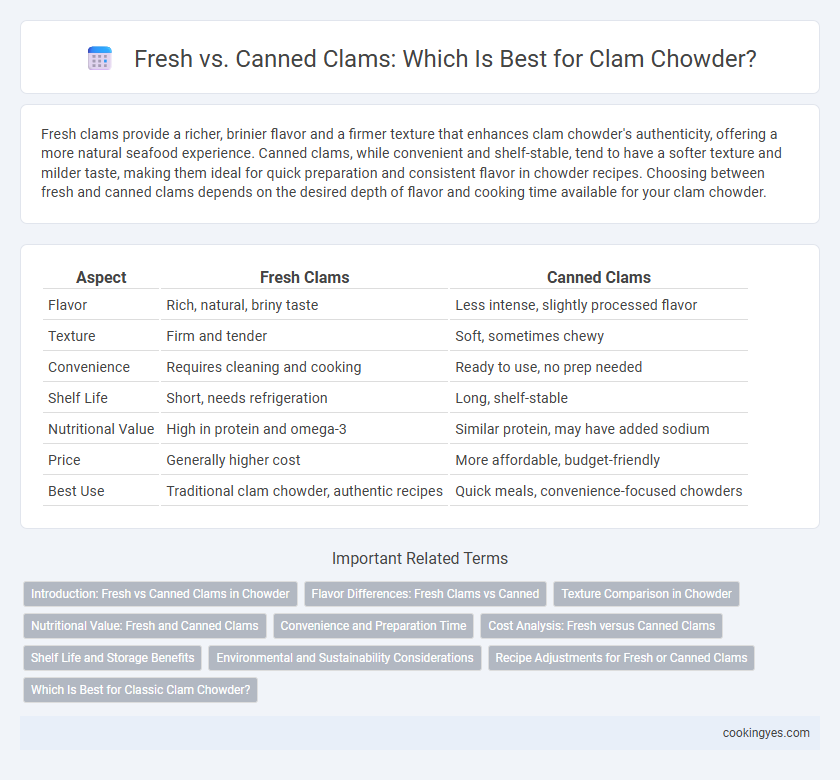Fresh clams provide a richer, brinier flavor and a firmer texture that enhances clam chowder's authenticity, offering a more natural seafood experience. Canned clams, while convenient and shelf-stable, tend to have a softer texture and milder taste, making them ideal for quick preparation and consistent flavor in chowder recipes. Choosing between fresh and canned clams depends on the desired depth of flavor and cooking time available for your clam chowder.
Table of Comparison
| Aspect | Fresh Clams | Canned Clams |
|---|---|---|
| Flavor | Rich, natural, briny taste | Less intense, slightly processed flavor |
| Texture | Firm and tender | Soft, sometimes chewy |
| Convenience | Requires cleaning and cooking | Ready to use, no prep needed |
| Shelf Life | Short, needs refrigeration | Long, shelf-stable |
| Nutritional Value | High in protein and omega-3 | Similar protein, may have added sodium |
| Price | Generally higher cost | More affordable, budget-friendly |
| Best Use | Traditional clam chowder, authentic recipes | Quick meals, convenience-focused chowders |
Introduction: Fresh vs Canned Clams in Chowder
Fresh clams offer a natural briny flavor and tender texture that elevate the authenticity of clam chowder, while canned clams provide convenience and consistent taste year-round. The choice between fresh and canned clams affects the chowder's depth of seafood essence and overall richness, with fresh clams often preferred by chefs for their superior quality. Canned clams, however, are a reliable option that ensures accessibility and ease without compromising the fundamental clam flavor.
Flavor Differences: Fresh Clams vs Canned
Fresh clams provide a briny, ocean-fresh flavor and a tender texture that enhances clam chowder's authenticity and depth. Canned clams offer convenience and a consistent, slightly muted taste due to preservation but lack the vibrant, natural sweetness of fresh clams. Choosing fresh clams results in a richer, more complex broth, while canned clams deliver accessibility without the nuanced flavor profile.
Texture Comparison in Chowder
Fresh clams in chowder provide a firm, chewy texture that enhances the soup's authenticity, while canned clams tend to be softer and sometimes rubbery due to preservation processes. The difference in texture affects the overall mouthfeel, with fresh clams offering a more satisfying bite and canned clams blending more uniformly into the chowder. Choosing fresh clams typically results in a chowder with distinct, textured clam pieces that elevate the dish's quality.
Nutritional Value: Fresh and Canned Clams
Fresh clams offer higher levels of vitamin B12, iron, and omega-3 fatty acids compared to canned clams, which often contain added sodium as a preservative. Canned clams provide convenience and longer shelf life but may have reduced nutrient density due to processing. Choosing fresh clams for clam chowder enhances its nutritional profile with more bioavailable minerals and healthier fats.
Convenience and Preparation Time
Fresh clams provide a richer flavor but require extensive cleaning and longer cooking times, making them less convenient for quick clam chowder preparation. Canned clams offer a time-saving alternative with pre-cooked, ready-to-use meat that simplifies the cooking process without sacrificing much taste. For fast and hassle-free clam chowder, canned clams are the preferred choice.
Cost Analysis: Fresh versus Canned Clams
Fresh clams typically cost between $8 to $12 per pound, while canned clams average around $2 to $4 per can, making canned clams a more budget-friendly option for clam chowder. Cost effectiveness depends on factors like seasonality, regional availability, and preparation time; fresh clams require cleaning and cooking, adding to labor costs. Despite the higher upfront price, fresh clams offer superior texture and flavor, which may justify the expense for premium clam chowder recipes.
Shelf Life and Storage Benefits
Fresh clams for clam chowder offer a shorter shelf life, typically lasting 1-2 days in the refrigerator, requiring immediate use for optimal flavor and texture. Canned clams provide extended shelf life, often up to 2-5 years unopened, allowing for convenient long-term storage without refrigeration. This preservation method maintains clam taste and quality, making canned clams a practical choice for consistent clam chowder preparation.
Environmental and Sustainability Considerations
Fresh clam chowder often relies on locally sourced clams, reducing carbon emissions associated with long-distance transportation and supporting sustainable fisheries practicing responsible harvesting methods. Canned clam products, while convenient and longer-lasting, may involve energy-intensive processing and packaging that contribute to environmental impact but can minimize food waste through extended shelf life. Choosing seafood certified by organizations like the Marine Stewardship Council (MSC) ensures that both fresh and canned clam options meet sustainability standards, promoting ocean health and resource conservation.
Recipe Adjustments for Fresh or Canned Clams
Using fresh clams in clam chowder requires longer cooking times to fully open shells and release natural brine, enhancing flavor complexity and texture. Canned clams offer convenience and a consistent saltiness but often necessitate reducing added salt and broth for balanced seasoning. Adjustments in simmering duration and liquid ratios ensure optimal taste and texture whether using fresh or canned clams.
Which Is Best for Classic Clam Chowder?
Fresh clams offer a briny, natural flavor and tender texture that elevate classic clam chowder's authenticity, capturing the essence of the sea. Canned clams provide convenience and consistent saltiness but often lack the depth and freshness critical to traditional recipes. For the best classic clam chowder, fresh clams retain superior taste and texture, making them the preferred choice for a rich, genuine flavor.
Fresh vs Canned for clam chowder Infographic

 cookingyes.com
cookingyes.com